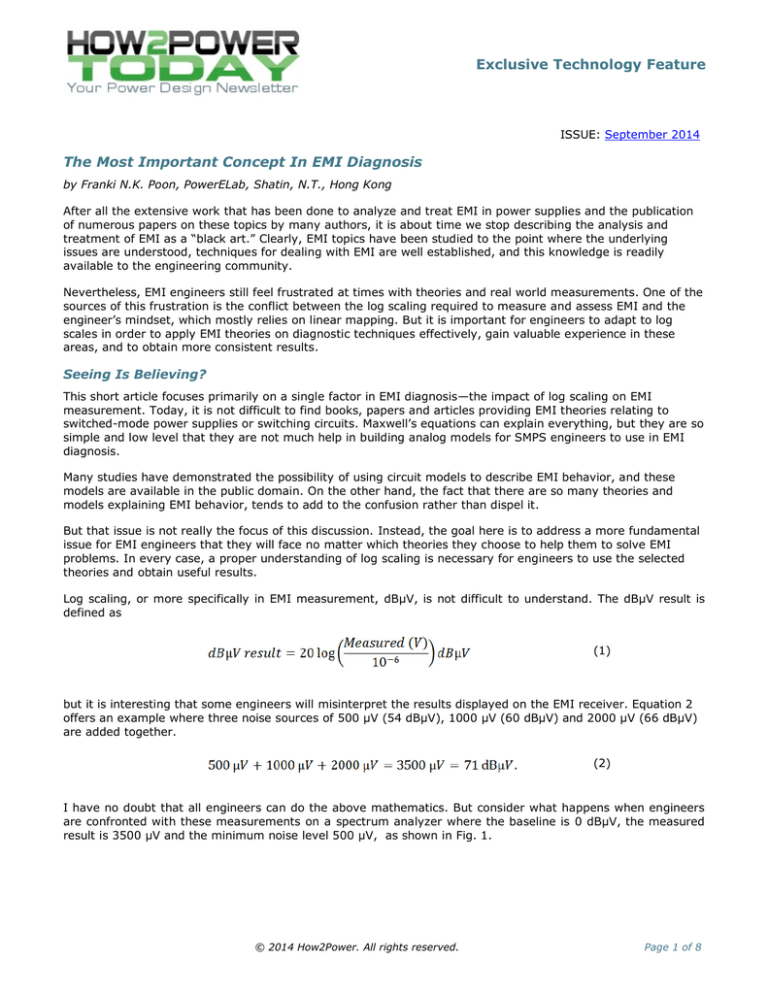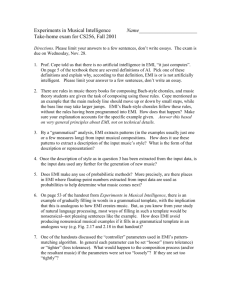
Exclusive Technology Feature
ISSUE: September 2014
The Most Important Concept In EMI Diagnosis
by Franki N.K. Poon, PowerELab, Shatin, N.T., Hong Kong
After all the extensive work that has been done to analyze and treat EMI in power supplies and the publication
of numerous papers on these topics by many authors, it is about time we stop describing the analysis and
treatment of EMI as a “black art.” Clearly, EMI topics have been studied to the point where the underlying
issues are understood, techniques for dealing with EMI are well established, and this knowledge is readily
available to the engineering community.
Nevertheless, EMI engineers still feel frustrated at times with theories and real world measurements. One of the
sources of this frustration is the conflict between the log scaling required to measure and assess EMI and the
engineer’s mindset, which mostly relies on linear mapping. But it is important for engineers to adapt to log
scales in order to apply EMI theories on diagnostic techniques effectively, gain valuable experience in these
areas, and to obtain more consistent results.
Seeing Is Believing?
This short article focuses primarily on a single factor in EMI diagnosis—the impact of log scaling on EMI
measurement. Today, it is not difficult to find books, papers and articles providing EMI theories relating to
switched-mode power supplies or switching circuits. Maxwell’s equations can explain everything, but they are so
simple and low level that they are not much help in building analog models for SMPS engineers to use in EMI
diagnosis.
Many studies have demonstrated the possibility of using circuit models to describe EMI behavior, and these
models are available in the public domain. On the other hand, the fact that there are so many theories and
models explaining EMI behavior, tends to add to the confusion rather than dispel it.
But that issue is not really the focus of this discussion. Instead, the goal here is to address a more fundamental
issue for EMI engineers that they will face no matter which theories they choose to help them to solve EMI
problems. In every case, a proper understanding of log scaling is necessary for engineers to use the selected
theories and obtain useful results.
Log scaling, or more specifically in EMI measurement, dBµV, is not difficult to understand. The dBµV result is
defined as
(1)
but it is interesting that some engineers will misinterpret the results displayed on the EMI receiver. Equation 2
offers an example where three noise sources of 500 µV (54 dBµV), 1000 µV (60 dBµV) and 2000 µV (66 dBµV)
are added together.
(2)
I have no doubt that all engineers can do the above mathematics. But consider what happens when engineers
are confronted with these measurements on a spectrum analyzer where the baseline is 0 dBµV, the measured
result is 3500 µV and the minimum noise level 500 µV, as shown in Fig. 1.
© 2014 How2Power. All rights reserved.
Page 1 of 8
Exclusive Technology Feature
Fig. 1. Measurements of 500 µV and 3500 µV produce readings of 54 dBµV and 71 dBµV,
respectively when viewed on an EMI receiver or spectrum analyzer’s log scale.
Now the tricky thing is this: suppose an engineer is not familiar with equation 1, and let’s say 3500 µV is the
worst case and 500 µV is the best case after an improvement. In this instance, the engineer may conclude that
the worst case (71 dBµV) is just a bit worse, around 1.3 times more, than the best case (54 dBµV), so
identifying the individual noise sources that contribute to the worst case reading is not too important because,
after all, they all exceed the limit line.
This reasoning is obviously not true as the worst-case measurement is actually seven times the magnitude of
the best case. The spectrum analyzer doesn’t lie, but it is easy for an engineer using a linear mindset to
misinterpret a log scale result and make the wrong decision in attempting to fix the EMI.
Now, I believe that most engineers would not be misled by the simple case described above. Nevertheless, in
the real world, the situation is more complex and similar kinds of mistakes are made.
Fig. 2 offers an example of a more-complex situation with multiple noise sources. It assumes that there are four
circuit elements contributing to the total EMI produced by a power supply. The first element is the transformer,
the second is the main MOSFET, the third is the filter capacitor and the last is the auxiliary circuit supply’s PWM
IC.
The results shown in the measurement on the right (Fig. 2b) are simulated, which of course, required that we
know the actual contributions of the individual noise sources in order to include them in our model. However,
for the purposes of this discussion, we’re assuming that these are the results the engineer is seeing on the
bench and so he or she does not initially know how much noise is contributed by each element of the EMI
model. That becomes the focus of the investigation.
Looking at the EMI measurement in Fig. 2, it is obvious that this power supply would fail due to its excessive
noise and this is not an unusual result during initial EMI testing of a power supply.
© 2014 How2Power. All rights reserved.
Page 2 of 8
Exclusive Technology Feature
(a)
(b)
Fig. 2. Example power supply EMI model containing multiple noise sources. An equivalent noise
source model is shown in (a) and a simulated measurement of the overal noise is shown in (b).
The model and the results represent what an engineer might see at the start of an EMI
investigation. The engineer has a model for the power supply EMI and a measurement of the
power supply’s overall EMI output, but it remains to be determined how much each element of
the model is contributing to the overall noise measurement.
A common technique to reduce EMI is to isolate the noise sources, find the most dominant noise source and
eliminate it. It is commonly emphasized that the transformer is the key element responsible for noise
emissions, and so the engineer should try every method to totally eliminate the EMI caused by the transformer.
Fig. 3 shows the results when the effect of the transformer is eliminated in our example. Fig. 3a shows the
equivalent noise source and Fig 3b the measurement of EMI. Unfortunately, the result is not much better than
the initial measurement, so it seems the transformer is a not dominant noise source.
(a)
(b)
Fig. 3. The results of eliminating the transformer’s contribution to power supply EMI. The
equivalent noise source model is shown here with the transformer removed (a) and the resulting
simulated measurement of the overal noise is shown in (b).
© 2014 How2Power. All rights reserved.
Page 3 of 8
Exclusive Technology Feature
A similar elimination of a noise source can be repeated with the MOSFET to see whether it is a dominant source.
Fig. 4 shows the equivalent model with the MOSFET removed and the resulting measurement of EMI. Once
again we see that the contribution of the MOSFET is not significant. In fact, comparing the Fig 4 result with that
in Fig 3, we see its noise contribution is even smaller than that of the transformer.
Fig. 4. Results of eliminating the MOSFET’s contribution to power supply EMI.
Knowing that the quality of the filter capacitor affects power supply EMI, the engineer may make another
attempt is reduce EMI by using a very good and expensive capacitor to build all filters, Fig. 5 shows the
resulting model and the associated result in our example. It is quite obvious that the filter capacitor had almost
no effect on EMI in this example.
Fig. 5. Results of eliminating capacitor effect on power supply EMI.
© 2014 How2Power. All rights reserved.
Page 4 of 8
Exclusive Technology Feature
Looking over the results obtained so far in our example, it would seem that only the transformer and MOSFET
affect the EMI result. And as a high-quality capacitor is expensive and has virtually no effect on EMI, a good
engineer will apply his or her efforts to eliminating both the transformer and MOSFET as sources of EMI.
Fig. 6 shows the power supply with these two elements removed and the resulting EMI. Although this result
looks better than results obtained by eliminating either one of the noise sources, it is still 10 dBµV above the
limit.
Fig. 6. Results of eliminating the combined transformer and MOSFET effects on power supply EMI.
Fig. 7 shows the engineer’s decision flow map in the example EMI investigation just presented. It is very
frustrating that the system has no dominant noise source and it would seem that there’s nothing more that can
be done to reduce the EMI. In this case, the engineer concludes that the situation is hopeless.
Fig. 7. Decision flow map for EMI troubleshooting example.
Believe In Facts Or Theories?
A more complete picture of this EMI example is disclosed in Fig. 8. Here, the model reveals the relative
amplitude of each noise source and that the previous conclusion about the capacitor was wrong. Fig. 8b shows
that the noise produced by the capacitor is significant and—when not corrected—causes the power supply EMI
to exceed the class B limit. This is the opposite of the conclusion drawn from Fig. 5.
© 2014 How2Power. All rights reserved.
Page 5 of 8
Exclusive Technology Feature
(a)
(b)
Fig. 8. Power supply noise source model with relative values of its noise source components (a)
and the resulting simulated measurement of overall supply EMI.
Fig. 9 shows that if we remove the contributions of the transformer, MOSFET and capacitor, the measurement
gives a low EMI level that complies with the class B limit with almost 10 dBµV margin. Clearly, the prior
conclusion during the EMI investigation that the situation was hopeless was wrong. So, the above experiments
illustrate how a misunderstanding of log-scale measurements may result in a painful, incorrect conclusion.
Fig. 9. A successful EMI investigation eliminates the noise contributions due to transformer,
MOSFET, and capacitor, thereby reducing the power supply’s overall EMI output to a level below
the class B requirement.
© 2014 How2Power. All rights reserved.
Page 6 of 8
Exclusive Technology Feature
In short, the effect of the log scale on EMI measurements depends on operations performed in previous steps.
As Fig. 5 illustrates, when none of the larger noise sources are eliminated in previous steps, the effect on the
overall EMI measurement of removing the capacitor is negligible because the resulting reduction in EMI won’t
be visible on a log scale. However, as Fig. 9 illustrates, when two of the existing noise sources have been
eliminated in prior steps, then the effect of the capacitor on EMI can be immediately seen. Here, the noise level
drops significantly from the measurement seen in Fig. 6 to that seen in Fig. 9.
This sensitivity of log scale EMI measurements to the order of operations in EMI reduction can also explain why
some experienced engineers emphasize the impact of the filter capacitor on power supply EMI, while other
engineers emphasize the effect of the transformer. In both cases, these engineers are telling the truth
according to their experiences, but they are also misinterpreting their measurements based on their
misunderstanding of the log scale.
Fig. 10 illustrates this phenomenon where different engineers come to different conclusions about which EMI
noise source was most important, depending on the sequence they used in eliminating noise sources. In the
first case, shown on the left in Fig 10, the engineer starts by eliminating the effect of the transformer and then
the MOSFET. After doing these steps, the engineer does not see a significant reduction in the log scale reading
for EMI. However, after eliminating the effect of the capacitor in the next step, the engineer sees that the noise
level drops by almost 20 dBµV. So, quite naturally, the engineer concludes that the capacitor was the most
significant EMI noise source in this design.
On the other hand, when another engineer performs an EMI investigation on the same design but follows a
different sequence of steps, the results may appear to be very different. In this case, which is depicted on the
right side of Fig. 10, the engineer eliminates the effect of the capacitor first, and it shows almost no effect. Then
the engineer eliminates the effect of MOSFET, which also produces no big change in the EMI reading. But finally,
when he or she removes the effect of the transformer, a large drop in noise level is seen on the display. Once
again, the engineer jumps to the conclusion that the transformer is really the significant source of EMI in this
design.
So, it is interesting to observe how engineers investigating the EMI produced by the same power supply design
using essentially the same procedures, but in a different order, can have very different experiences leading to
very different conclusions. One further and unfortunate side effect of these different experiences is that the
engineers often share their conflicting stories with new engineers, which only leads to confusion in an area
where beginners are unlikely to have much experience.
Fig. 10. Log scaling effect with EMI noise sources eliminated in different sequences.
© 2014 How2Power. All rights reserved.
Page 7 of 8
Exclusive Technology Feature
Conclusion
Log scaling is a compression process. The degree to which the reading is changed by adding or subtracting a
signal depends on the level of the prior signal content. If the previous signal content is ignored, one can’t draw
any meaningful conclusion. Significant change in a log scale reading happens only when adding or subtracting a
signal that is the main signal in the total content.
So, going back to the example in Fig. 8, we see that the impact of the MOSFET (the second largest noise
source) can only be seen on a log-scale measurement, after the effect of the transformer (the largest noise
source) has been removed. Similarly, the effect of the capacitor (the third largest noise source), can only be
observed after the effects of both the transformer and MOSFET have been removed. So the sensitivity of the
log-scale measurement to the order of operations is important here.
But also recall that in the initial investigation, the engineer was led astray by the search for a dominant noise
source, which caused him or her to overlook the cumulative effect of eliminating multiple noise sources. As a
single isolated step, eliminating the effect of the capacitor did not produce a significant change in the EMI
measurement because, as observed on a log scale, its noise signal level was not significant in comparison with
the original EMI signal level. But removing the effects of the transformer and capacitor reduced the EMI signal
level to a point where the capacitor’s contribution was significant. And on a log scale, you’ll only see the
significant reductions. Therefore, rather than searching for a dominant noise source, engineers should approach
an EMI investigation knowing that they will probably need to attenuate multiple noise sources in combination to
meet their goal.
In the EMI field, it is usually the last step in the whole process of noise source elimination that yields results.
While clearly the last step is necessary, engineers should not view that result as proof that the last noise source
removed was the big one in that particular design, or what’s worse, use that experience to make
generalizations about EMI noise sources in other power supply designs.
EMI behaviors are complex, representing the combination of many noise sources conducting or radiating across
many paths. In light of this complexity, it is easy to draw the wrong conclusion about which source or sources
are responsible. I would like to summarize all the above examples and explanations in a short sentence.
However, I find that I can’t express it any better than my friend Peter Bardos who observed, “You will not see a
result until you have eliminated the last problem.”
Following this approach should help to make the engineer’s job of solving EMI problems a little easier, less
frustrating, and possibly, more interesting. It may even help us in other complex areas of life, where we find
that it’s not one main problem that needs to be solved, but many.
About The Author
N. K. Poon is the co-founder of PowerELab Ltd., a spin-off company from the
University of Hong Kong, and the creator of the Web-based software PowerEsim.
Poon received the B.Eng. degree (with honors) in electronic engineering from the
City University of Hong Kong, in 1995, and the Ph.D. degree from Hong Kong
Polytechnic University in 2003. After graduation, he worked at Artesyn Technologies
(Asia Pacific) for three and a half years before joining the Power Electronics
Laboratory at the University of Hong Kong. His current interest includes softswitching techniques, EMI modeling, PFC topologies, synchronous rectification,
converter modeling, PWM inverters, simulation techniques, and fast transient
regulators. Poon is also the key inventor of more than 20 patents, and has
published more than 50 journal and conference papers.
For further reading on EMI issues in power supply design, see the How2Power Design Guide, select the
Advanced Search option, go to Search by Design Guide Category and select “EMI and EMC” in the Design Area
category.
© 2014 How2Power. All rights reserved.
Page 8 of 8







![[ ] [ ] ( )](http://s2.studylib.net/store/data/011910597_1-a3eef2b7e8a588bc8a51e394ff0b5e0e-300x300.png)